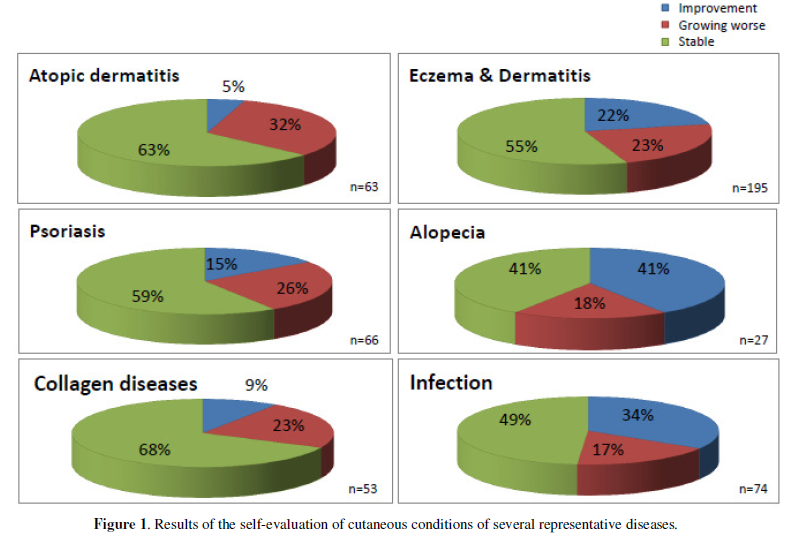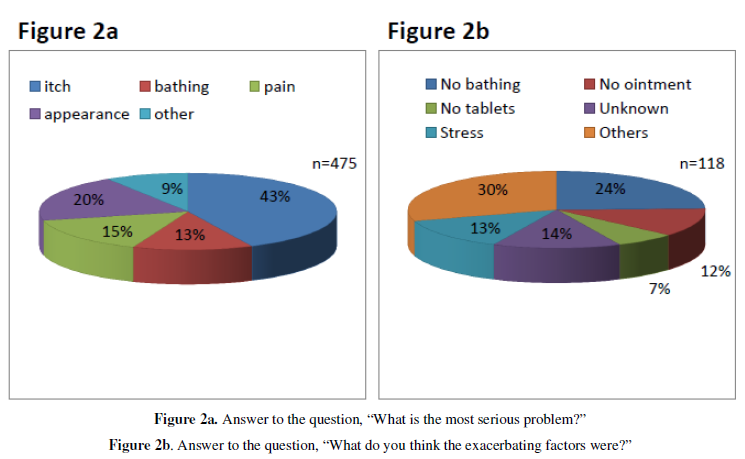927
Views & Citations10
Likes & Shares
Due to the Tohoku disaster, people living in
Fukushima were confronted with many problems. They were not injured by the
Tsunami, but were severely affected both environmentally and mentally. Patients
who had been followed up at our dermatology department had to face such issues
as rapid changes in lifestyle, shortage of daily necessities such as
medications and baths, as well as an anxiety over the effects of radiation.
Fukushima Medical University Hospital closed its outpatient clinic for nearly
two weeks following the disaster. When we re-opened our clinic, we conducted a
questionnaire analysis subjected 973 patients who visited our out-patient
clinic, by asking patients of their skin conditions and how they coped with
skin disorders. At first, we supposed that various skin conditions were
exacerbated by different circumstances caused by the disaster; however,
overall, exacerbation of skin conditions was not as severe as was anticipated.
We herein describe the status of cutaneous conditions in those early days.
INTRODUCTION
On March 11th2011, a big earthquake (magnitude 9.0) struck the
Tohoku region of Japan, which was then devastated by a subsequent giant
tsunami. These disasters led to further catastrophe in the form of the
‘Fukushima disaster’, or the nuclear power plant accident, which created more
problems for Tohoku residents, especially for those living in the eastern
coastal areas of Fukushima Prefecture. A number of studies related to the
effects of Tohoku disasters on various disorders have been carried out; however,
there are very few reports on the influences of the disaster on cutaneous
conditions. We examined whether the Tohoku disaster affected various cutaneous
conditions.
METHODS
Immediately following the 2011 Tohoku Earthquake (The Great East Japan Earthquake), Fukushima Medical University Hospital closed its outpatient clinics, for all non-emergency cases. We re-opened the clinics on March 26th 2011, two weeks after the disaster. After obtaining the approval of our Institutional Review Board, we carried out a questionnaire analysis of the effect of the disaster on cutaneous conditions, objecting to the outpatients who visited the Department of Dermatology of Fukushima Medical University Hospital until the end of June in 2011. The questionnaire consisted of questions, mainly asking about skin conditions such as the following: “How is your skin condition?”“What is the most serious trouble?”“If your skin condition has worsened, what do you think the exacerbating factors were?”“How many folds did your skin condition worsen?” and “How have you been treated while our hospital was closed?”
RESULTS
The total number of patients was 973, consisting of 436 males and 425
females (112 were unknown). The mean age was 53.2 years old, ranging from 0 to
94 years old. Regarding the patients’ skin disorders, we evaluated atopic
dermatitis (n=63), eczema (n=195), psoriasis (n=66), alopecia (n=27), collagen
disease (n=53), and infectious disease (n=74). Contrary to our initial
expectations, the proportion of those who experienced exacerbation of skin
diseases was remarkably low, and those with stable skin conditions were the
most common. As is shown in Figure 1,
worsening of condition was most frequently observed in atopic dermatitis (32%),
followed by psoriasis (26%). Of the patients who had remained in their house
(n=783) and those who had been living in the shelter (n=47), 17% and 28%
complained of worsening of skin conditions, respectively. Moreover, despite
self-evaluation, the worsening ratio of patients living in the shelter
(2.75-fold exacerbation) was higher than that of patients living in their house
(1.92-fold exacerbation). An additional question regarding embarrassing factors
was asked to the patients who were living in areas where water supply was
suspended (n=475). Itching was the most commonly reported problem (43%) (Figure 2a). We next examined exacerbating
factors (n=118). No bathing (24%, n=37) was the most commonly reported factor,
followed by shortage of ointment (12%, n=18) or tablets (7%, n=10), stress
(13%, n=20), and others (30%, n=45) (Figure
2b). “Others” included treatment interruption, fatigue, lifestyle changes,
earthquakes, evacuation, ineffective drugs, and coldness. While our hospital
was closed, 27% of the patients obtained drugs at other clinics, 23% purchased
drugs at pharmacies, and 43% received no treatment.
DISCUSSION
Since the 2011 Tohoku disaster, various effects of the disasters on various conditions, such as infectious diseases (influenza, tuberculosis, pneumonia), cardiovascular diseases, diabetes, dialysis, gastrointestinal diseases, respiratory disease, asthma, deep vein thrombosis, as well as various aspects not directly related to radiation, have been reported [1]. By contrast, studies focusing on cutaneous conditions are very few [2, 3]. Murata et al. [2] reported that, during the treatment of victims of the tsunami in the evacuation centers by the emergency team, infections-infestations were found to be the most prevalent skin conditions, followed by traumatic skin disorders and eczema. By contrast, the subjects of our study are different, as they were not injured by the tsunami; and most of them remained in Fukushima. They had many problems, such as concern of radiation, rapid changes of lifestyle, shortage of daily necessities, and so on, which may affect skin conditions.
A number
of studies have demonstrated that mental stress due to miserable disasters
exerts a significant influence on various diseases. The residents of evacuation
zones in Fukushima, due to the Tohoku disaster, showed severe psychological
distress [4]. In dermatological field, several skin disorders, such as atopic
dermatitis, urticarial, psoriasis, acne, alopecia, or herpes zoster, are known
to be affected by psychological stress. We herein reported the influences of
the Tohoku disaster on various inflammatory skin disorders, by analyzing the
answers to the questionnaire we obtained from the patients, during the three
months immediately following the disaster. Our results showed that the number
of patients who felt significant worsening of their skin conditions was much
lower than we had anticipated. The reason may be that the lifelines were
stopped for relatively short periods, i.e.
at the most one week. Also, a limitation of this research was that the method
was self-evaluation. Furthermore, we could not evaluate all patients who had
been treated in our outpatient clinic as many had evacuated due to the
disaster. Patients who had remained in Fukushima may have been much less
stressed than those who evacuated from Fukushima, worrying about the influences
of radioactivity especially on their small children. Nevertheless, atopic
dermatitis and psoriasis were the frequent conditions showing exacerbation,
both of which is affected by mental stress [5-7].
In
previous studies on serious stress at the time of Hanshin Great Earthquake,
subjective distress was the most responsible factor for exacerbating atopic
dermatitis [8]. Other factors such as medication shortage, bathing stoppage,
and dusty environment were also representative exacerbation causes [8]. Stress interacts
with various immune mechanisms, via
neuro-immune pathways, by acting on the central nervous system and then
affecting the endocrine system. The stress signals activate the central
hypothalamic-pituitary-adrenal (HPA) axis to release stress hormones [9]. In
addition, many hormones are also generated in the skin, and peripheral HPA axis
(skin-HPA axis) is influenced by stress to release neurotransmitters [10].
Stress also attenuates HPA axis response, shifts to the Th2 immune response,
and modulates the innate and adaptive cutaneous immune responses.
Our study had several limitations, such as lack
of control populations and relatively small number of patients in each group.
Nevertheless, we believe that it is important to make a record of skin conditions
during the chaotic situations such as that following in the Tohoku disaster.
1. Hasegawa A, Tanigawa K, Ohtsuru A,
et al. (2015) Health effects of radiation and other health problems in the
aftermath of nuclear accidents, with an emphasis on Fukushima. Lancet 386:
479-488.
2. Murata S, Hashiguchi N, Shimizu M,
et al. (2012) Skin disorders and the role of dermatologists after the tsunami
in Japan. J Eur Acad Dermatol Venereol 26: 923-924.
3. Nasu M, Kobayashi N, Aiba S (2013)
A child case of Gardner-Diamond syndrome triggered by the Tohoku-Pacific Ocean
Earthquake. Eur J Dermatol 23: 425-427.
4. Yabe H, Suzuki Y, Mashiko H, et
al. (2014) Psychological distress after the Great East Japan Earthquake and
Fukushima Daiichi Nuclear Power Plant accident: results of a mental health and
lifestyle survey through the Fukushima Health Management Survey in FY2011 and
FY2012. Fukushima J Med Sci 60: 57-67.
5. Senra MS, Wollenberg A (2014)
Psychodermatological aspects of atopic dermatitis. Br J Dermatol 170 (Suppl):
38-43.
6. Martín-Brufau R, Romero-Brufau S,
Martín-Gorgojo C, Brufau-Redondo C, Corbalan J, et al. (2015) Psoriasis lesions
are associated with specific types of emotions: emotional profile in psoriasis.
Eur J Dermatol 25: 329-334.
7. Hall JMF, des Cruser A, Podawiltz
A, Mummert DI, Jones H, et al. (2012) Psychological stress and the cutaneous
immune response: roles of the HPA axis and the sympathetic nervous system in
atopic dermatitis and psoriasis. Dermatol Res Pract 2012: 403908.
8. Kodama A, Horikawa T, Suzuki T, et
al. (1999) Effect of stress on atopic dermatitis: investigation in patients
after the Great Hanshin Earthquake. J Allergy Clin Immunol104: 173-176.
9. Hendrix S (2008) Neuroimmune
communication in skin: far from peripheral. J Invest Dermatol 128: 260-261.
10. Kim JE, Cho BK, Cho DH, Park HJ
(2013) Expression of hypothalamic-pituitary-adrenal axis in common skin
diseases: evidence of its association with stress-related disease activity.
Acta Derm Venereol 93: 387-393.
QUICK LINKS
- SUBMIT MANUSCRIPT
- RECOMMEND THE JOURNAL
-
SUBSCRIBE FOR ALERTS
RELATED JOURNALS
- International Journal of Clinical Case Studies and Reports (ISSN:2641-5771)
- International Journal of AIDS (ISSN: 2644-3023)
- Journal of Spine Diseases
- International Journal of Surgery and Invasive Procedures (ISSN:2640-0820)
- Journal of Immunology Research and Therapy (ISSN:2472-727X)
- Journal of Cardiology and Diagnostics Research (ISSN:2639-4634)
- Journal of Forensic Research and Criminal Investigation (ISSN: 2640-0846)



